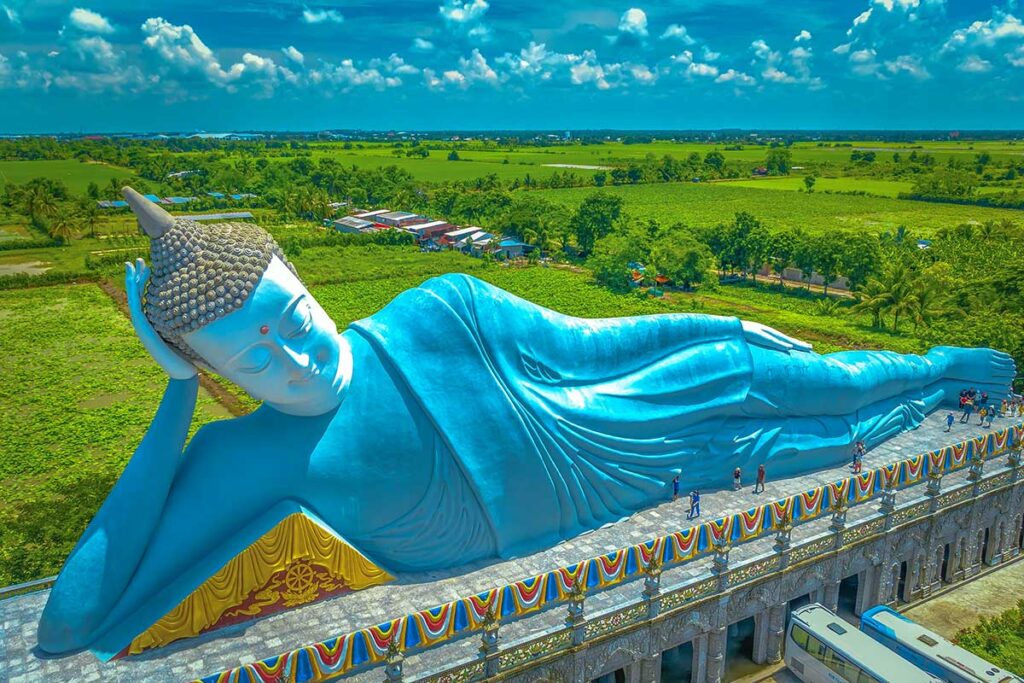What is Som Rong Pagoda
Location & Setting
Som Rong Pagoda sits in Soc Trang City, right in the heart of Vietnam’s Mekong Delta. Unlike rural temples hidden among rice fields, this one is in an urban setting, surrounded by the bustle of a provincial capital. It’s easy to reach from nearby Can Tho or even Ho Chi Minh City, which is part of the reason it has become one of the most photographed religious sites in the region.
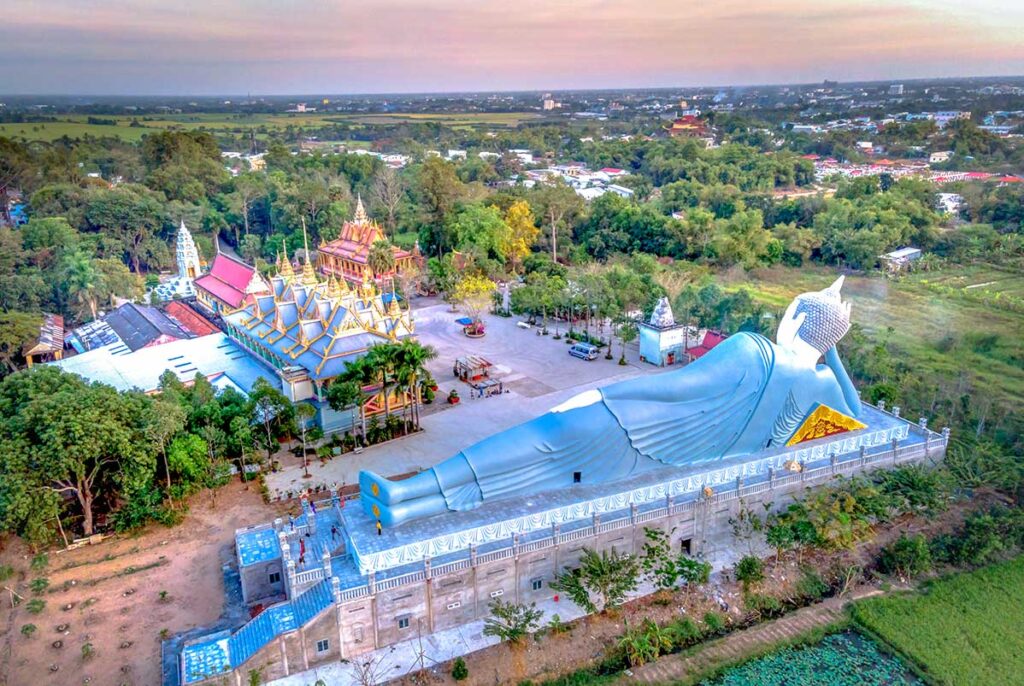
History & Name
The pagoda dates back to the late 18th century, with most sources pointing to 1785. Its first form was a humble structure made of bamboo, wood, and thatched roofing, built by the local Khmer community. Over the centuries it has been rebuilt several times under successive abbots, gradually becoming larger and more ornate. The name “Som Rong” comes from the Som Rong trees that once grew abundantly around the area, a reminder of the deep connection between the Khmer people and the landscape they live in.
Religion & Living Temple
Som Rong Pagoda is part of the Southern Khmer Theravada Buddhist tradition. It is not just a tourist stop but an active temple with monks living, studying, and teaching here. The sala hall is used for community gatherings and Buddhist education, and the grounds host some of the Khmer community’s most important religious festivals. These include:
- Chol Chnam Thmay – the Khmer New Year in April.
- Ok Om Bok – the rice-flake offering and moon worship festival in the 10th lunar month.
- Kathina – the robe-offering ceremony held in late autumn.
- Sen Dolta – a festival to honor ancestors, similar in meaning to Vietnam’s Vu Lan.
Together, the architecture, rituals, and festivals make Som Rong more than a sightseeing stop—it’s one of the cultural and spiritual centers for Khmer people in Soc Trang, and a place where their heritage continues to thrive.
Highlights when visiting Som Rong Pagoda
1. The 63-Meter Reclining Buddha (Main Photo Spot)
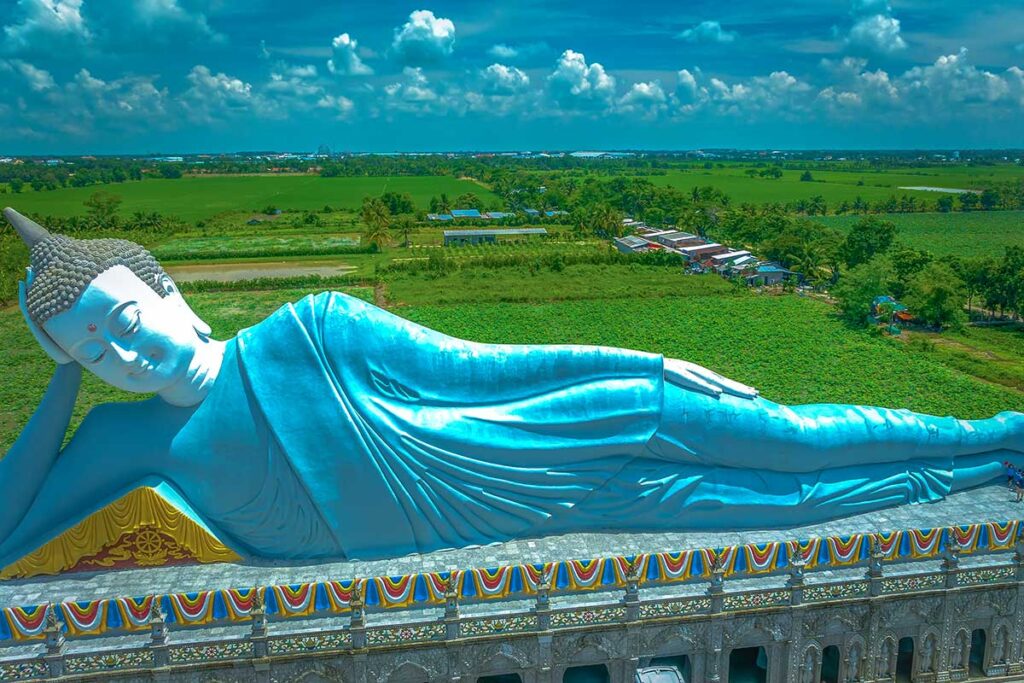
The star of Som Rong Pagoda is the giant reclining Buddha, measuring around 63 meters in length and 22.5 meters in height, with a weight of nearly 490 tons. It rests on a raised platform that you can walk around, offering views from different angles.
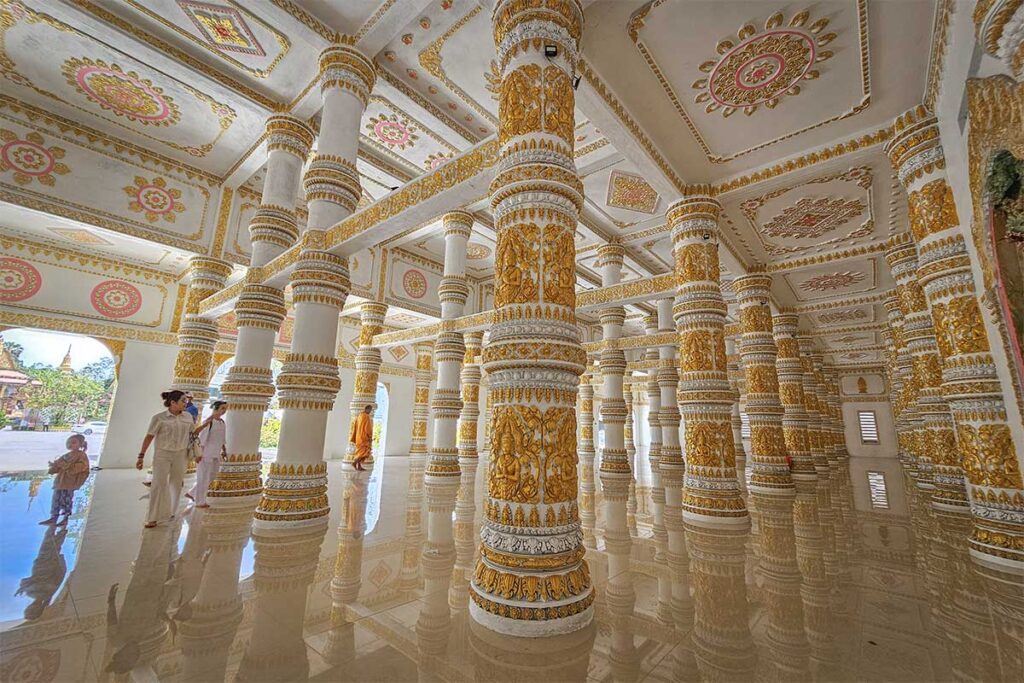
Underneath the statue is a plain white hall with tall golden-tipped columns—minimalist compared to the exterior, but it gives a sense of scale.
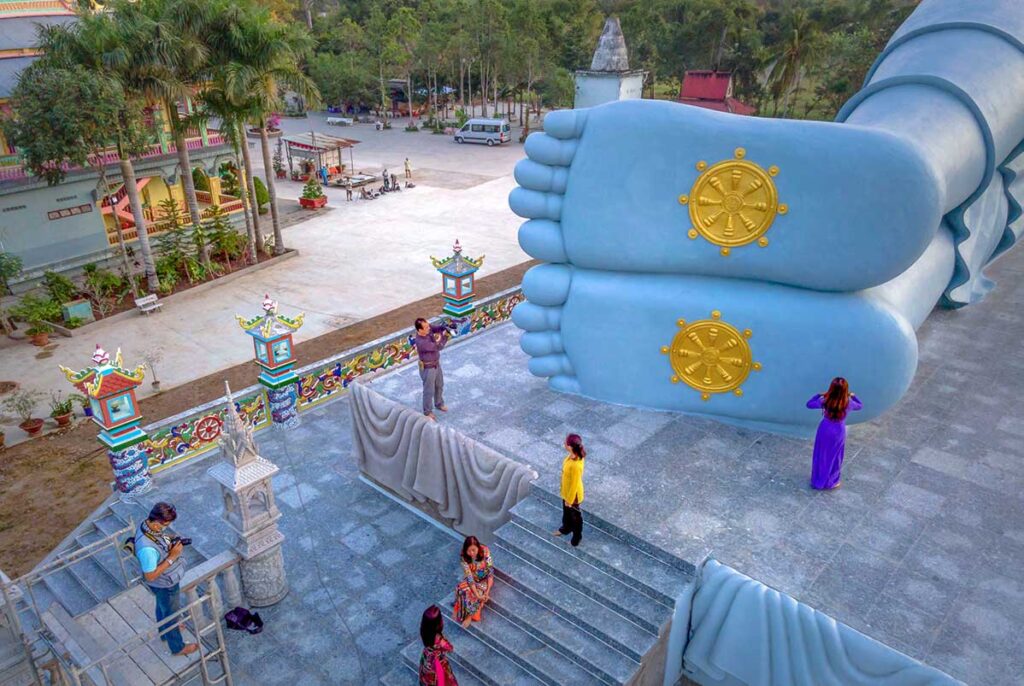
On the soles of the Buddha’s feet are symbolic patterns often interpreted in Buddhist art as dharma wheels. The statue can be seen from far away, but up close the sheer size is more striking. The best time to photograph it is late afternoon when the light softens and the crowds thin out.
2. Main Hall (Chanh Dien) – Khmer Decorative Program
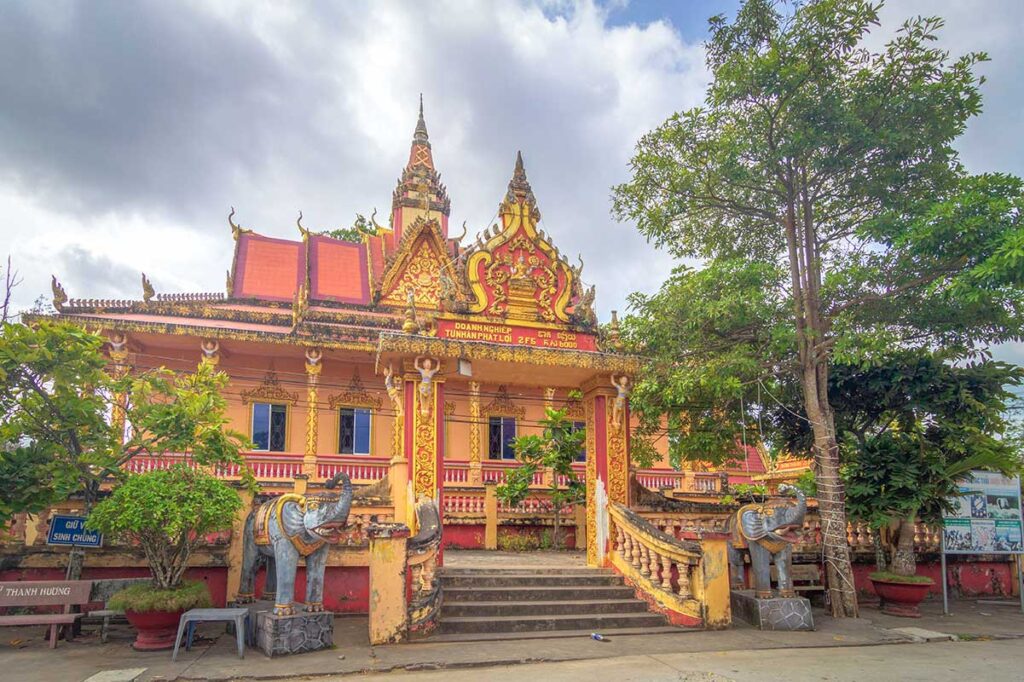
The main worship hall showcases Khmer architecture with its layered roof, naga serpent motifs, and stylized dragons at the edges. Decorative figures of Keynor (a celestial dancer with bird features) and Krud (Garuda, the mythical bird) appear around the columns, while qilin guardians mark some of the entrances. This hall is primarily a sacred space for prayer, so while visitors are usually welcome to step inside, it’s important to dress modestly, remove hats, and keep voices low.
3. Gray Stupa at the Entrance
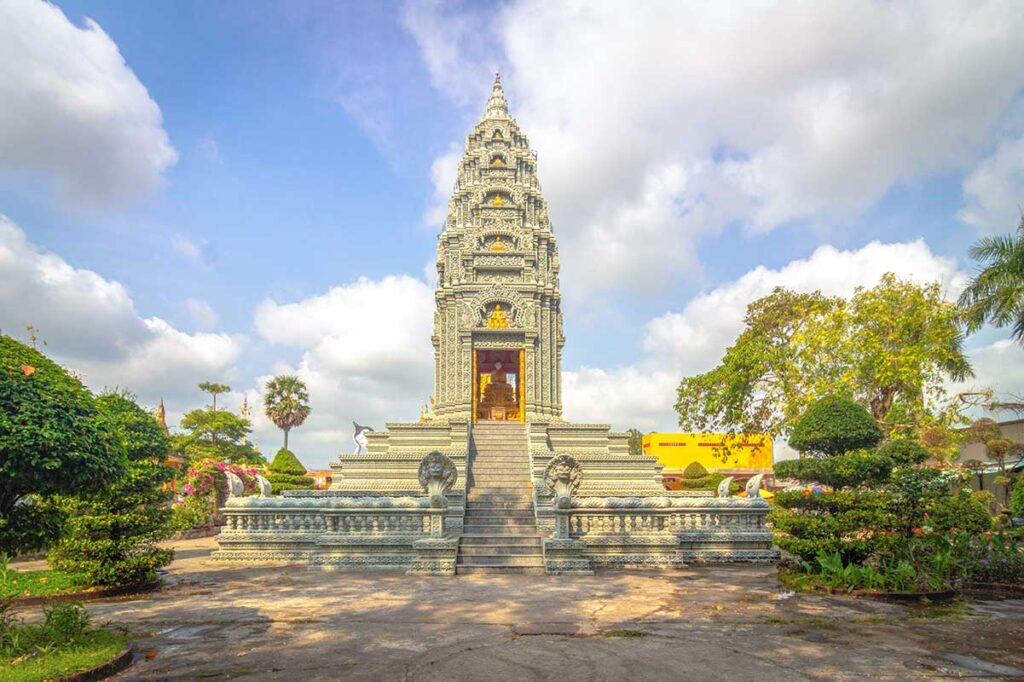
At the front of the complex stands a striking gray stupa, about 25 meters high and covering an area of around 100 square meters. Its four entrances and four faces symbolize the Buddhist virtues of loving-kindness, compassion, joy, and equanimity. Naga stairways guard the steps, and inside are urns holding the ashes of monks and abbots. With its tall, block-like design and gray stone color, it photographs well, especially from the frontal staircase or when framed against the sunset sky.
4. Sala (Gathering/Teaching Hall)
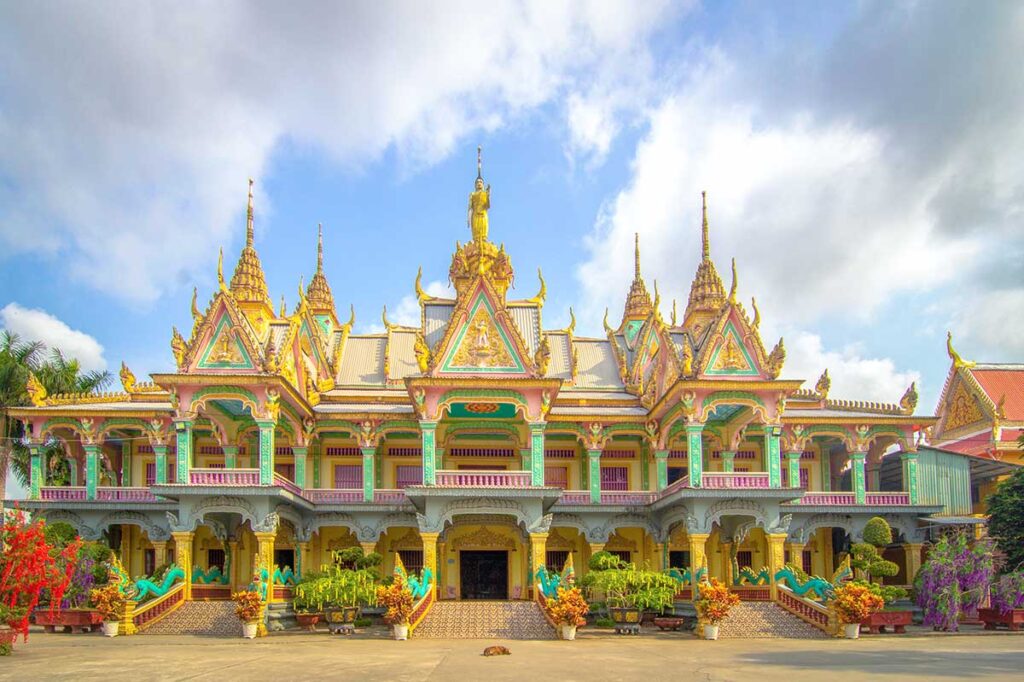
A newer addition to the pagoda, the sala is both practical and decorative. On the outside you’ll see naga guardrails, apsara reliefs, and Garuda figures along the roofline. Inside, it serves as a space for teaching Buddhist doctrine and hosting community events. Travelers can often admire the building from outside, but whether you can enter depends on the schedule—sometimes it’s used for ceremonies or classes, and it may not always be accessible for casual visitors.
5. Old Sala – Library
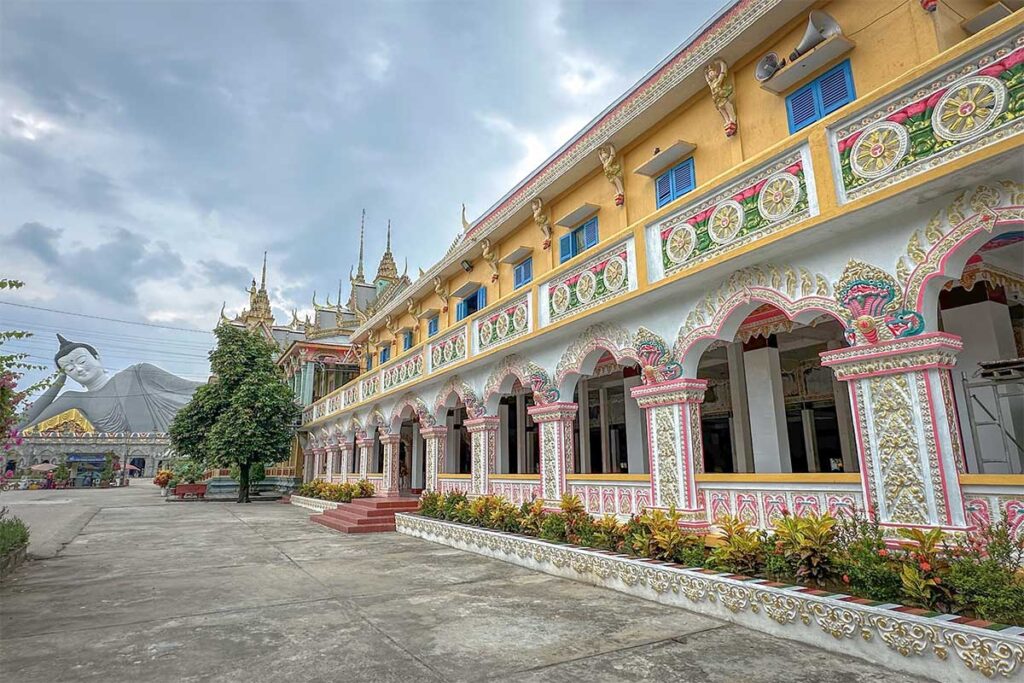
The previous sala building has been converted into a small library with a collection of Buddhist texts and community books. It’s more functional than decorative, and unless you’re deeply interested, it’s not a major stop for most visitors. Still, it’s worth noting that the pagoda also plays an educational role beyond being a place of worship.
6. Courtyard & Secondary Structures
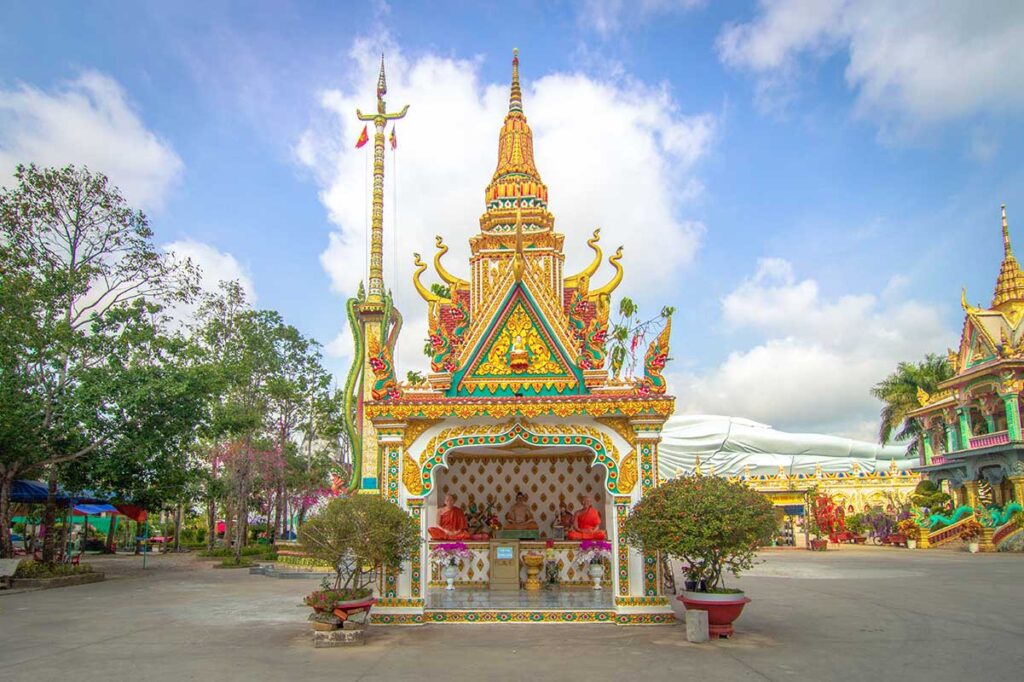
Scattered around the grounds are smaller pavilions and shrines in Khmer style, with Buddha images inside. There are also a few statues of animals like elephants or mythical creatures, typical of Khmer temple complexes. For most travelers, these make for a pleasant walk around the courtyard but are not highlights compared to the Buddha statue, stupa, or main hall.
Location & How to get there
Where is Som Rong Pagoda?
Som Rong Pagoda is located in Soc Trang City, a provincial capital in the Mekong Delta. The city lies about 60 km south of Can Tho (roughly a 1.5-hour drive) and around 200 km from Ho Chi Minh City (4–5 hours by road). The pagoda itself is just outside the center of town and sits along National Highway 60, making it one of the easier sites to reach compared to rural temples hidden in the countryside.
Private car with driver (Most Convenient)
The simplest way for most travelers is to arrange a private car with driver. From Can Tho, you can reach Soc Trang in under two hours, which allows enough time to combine Som Rong Pagoda with other Khmer temples like Bat Pagoda or Clay Pagoda. From Ho Chi Minh City, the drive is longer but still manageable for an overnight or two-day trip. Adding a local guide is optional but helpful if you want explanations about Khmer religious art and festivals that aren’t covered by signage.
Travel independently
If you’re already in Soc Trang, getting to the pagoda is straightforward:
- Taxi or ride-hailing: A short and inexpensive ride from the city center.
- Motorbike/scooter rental: Possible if you’re confident in Delta traffic, which can be busy with trucks and buses on the main highways.
- Cycling: An option for those staying locally; the roads are flat, but the heat and lack of shade make it tough in the middle of the day.
Parking & Map note
There is space for cars and motorbikes near the entrance, and taxis can drop you off right at the gate. Always double-check the map pin before setting out, as Soc Trang has multiple pagodas with similar Khmer names. Searching for “Som Rong Pagoda Soc Trang” will usually bring up the correct spot.
Practical visiting information & Tips
Opening Hours & Fees
Som Rong Pagoda is open daily, and entry is free of charge. Donations are welcome but never pushed. If you want a calmer visit, go in the early morning (7:00–9:00) or late afternoon (16:00–18:00) when the heat is less intense and the light is better for photos. Weekends and public holidays tend to bring more domestic visitors, so plan accordingly if you prefer a quieter atmosphere.
Dress Code & Etiquette
As with any active temple, respectful clothing is important—cover shoulders and knees if you plan to step inside worship areas. Remove hats and sunglasses when entering halls, and keep your voice down. Statues, naga railings, and animal figures are sacred symbols, not playgrounds—so avoid climbing or leaning on them for photos.
Photography
You’re free to take photos around the grounds, and most visitors do. Just be discreet during prayer times and avoid photographing monks or locals without asking. Drones aren’t appropriate unless you have prior permission. For the best photos, use wide angles to capture the scale of the reclining Buddha, and try for symmetry shots at the stupa.
Heat, Sun & Facilities
The courtyards have little shade, so a hat, sunscreen, and a bottle of water will make your visit more comfortable. Don’t count on finding much in the way of cafés or shaded seating inside the pagoda grounds. Toilet facilities may exist but aren’t always in great condition, so plan your visit around that.
Festival days
During Khmer festivals like Chol Chnam Thmay (New Year) or Ok Om Bok (Moon Festival), the pagoda comes alive with ceremonies, decorations, and large crowds. It’s a colorful time to visit, but also much busier. Arrive early, expect longer times to move around, and embrace the lively atmosphere if you go during these days.
Sights nearby to combine with (Soc Trang)
Soc Trang is home to a rich Khmer heritage, and it’s easy to combine Som Rong Pagoda with other temples and cultural sites in the city or nearby. If you have half a day or longer, these are worth considering:
- Bat Pagoda (Chùa Dơi / Mahatup) – Known for its resident bat colony roosting in the trees and for its impressive Khmer-style sanctuary.
- Kh’leang Pagoda – One of the oldest Khmer pagodas in Soc Trang, valued for its detailed Theravada art and architecture.
- Clay Pagoda (Chùa Đất Sét) – Famous for its handmade clay sculptures, including thousands of mini statues and giant ceremonial candles.
- Chen Kieu (Bowl) Pagoda – A colorful temple that blends Khmer and Chinese design, decorated with pieces of porcelain bowls.
- Soc Trang Museum – A small but useful stop if you want to understand Khmer culture, local history, and traditional crafts.
- Nga Nam Floating Market – A lively morning market where boats converge from five canals; it takes planning as it’s best visited very early.
- Seasonal highlight: Ghe Ngo Boat Race – Held during the Ok Om Bok Festival, this race is one of the most energetic cultural events in Soc Trang.
Is Som Rong Pagoda worth visiting?
Som Rong Pagoda is worth a stop if you’re spending time in Soc Trang or exploring Khmer heritage in the Mekong Delta. The enormous reclining Buddha is undeniably impressive and one of the most photogenic religious landmarks in the area. The grounds are tidy, easy to reach, and free to enter, which makes it a convenient addition to any itinerary.
That said, it’s not the most intricate or atmospheric temple in Vietnam. Some of the buildings are relatively new, so if you’re expecting centuries-old detail like you’d see at Angkor-style temples, you may find it less captivating. Shade is limited, and unless you’re keen on photographing from different angles, most visits last around 30–60 minutes.
Overall, it’s best suited for travelers who enjoy Khmer architecture, cultural sightseeing, or capturing unique photos. Combined with nearby pagodas such as Bat Pagoda or Clay Pagoda, Som Rong becomes part of a rewarding temple circuit in Soc Trang.
